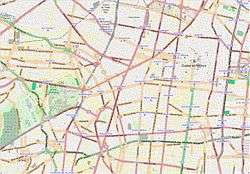Metro Centro Médico
Metro Centro Médico (Spanish: Estación Centro Médico) is an underground metro station on the Mexico City Metro.[2][3] It is located in the Cuauhtémoc borough of Mexico City.[2] It is a transfer station for both Lines 3 and 9.[2][3]
General information
The station logo represents the caduceus, a variant of the Rod of Aesculapius, the Greek god of medicine.[2] Its name refers to the Centro Médico Siglo XXI general hospital, located above the metro station.[4][5][6] The station opened along Line 3 on 7 June 1980 when Centro Médico served briefly as the southern terminus of that line.[7] Line 3 service then extended further southward toward Zapata a year later by 25 August 1980.[7] The Centro Médico Siglo XXI was almost destroyed by the 1985 earthquake.[8] The station served as the western terminus of Line 9 (which went east towards Pantitlán) starting on 26 August 1987.[7] Westward service on Line 9 toward Tacubaya started a year later on 29 August 1988.[7]
Metro Centro Médico is directly connected to the main entrance of Centro Médico by a set of escalators. This metro station has facilities for the handicapped, a cultural display, and an information desk.[2]
Metro Centro Médico serves the Roma Sur, Doctores and Buenos Aires neighbourhoods.[2] It is located at the intersection of Avenida Cuauhtemoc and Eje 3 Sur Baja California, just a block north of Viaducto Miguel Alemán, an important east-west highway.[9][10] The southern exits at the Line 3 end of the station are close to the historic Panteón Francés (French Cemetery) in which important civil and military Mexican figures are buried.[9][10][11]
 Station sign
Station sign- Centro Médico Siglo XXI (Medical Center of the 21st Century) with metro entrance
- Parque Delta Mall near Metro Centro Médico
References
- "Afluencia de estación por línea 2018" (in Spanish). Sistema Transporte Colectivo Metro. 2019. Archived from the original on 6 June 2019. Retrieved 8 April 2020.
- "Centro Médico" (in Spanish). Sistema de Transporte Colectivo. Archived from the original on 27 September 2011. Retrieved 29 July 2011.
- Archambault, Richard. "Centro Médico - Mexico City Metro System". Retrieved 29 July 2011.
- "CDS Centro Médico" (in Spanish). Retrieved 29 July 2011.
- "Localización" (in Spanish). La Unidad Medica de Alta Expecialidad Hospital de Pediatria del Centro Médico Nacional Siglo XXI. Retrieved 29 July 2011.
- "::: Hospital de Cardiología CMN S.XXI :::" (in Spanish). Archived from the original on 28 March 2012. Retrieved 29 July 2011.
- Monroy, Marco. Schwandl, Robert (ed.). "Opening Dates for Mexico City's Subway". Retrieved 14 August 2011.
- Soberon, Guillermo Julio; Jaime Sepulveda (June 1986). "The Health Care Reform in Mexico: Before and After the 1985 Earthquakes". American Journal of Public Health. 76 (6): 673–680. doi:10.2105/AJPH.76.6.673. PMC 1646758. PMID 3706595.
- "Cumulo 11: Centro Médico Siglo XXI" (PDF). Instituto Nacional de Estadística y Geografía. Archived from the original (PDF) on 6 October 2011. Retrieved 29 July 2011.
- "Metro Centro Médico". Wikimapia. Retrieved 29 July 2011.
- "Panteon Francés". Retrieved 29 July 2011.

